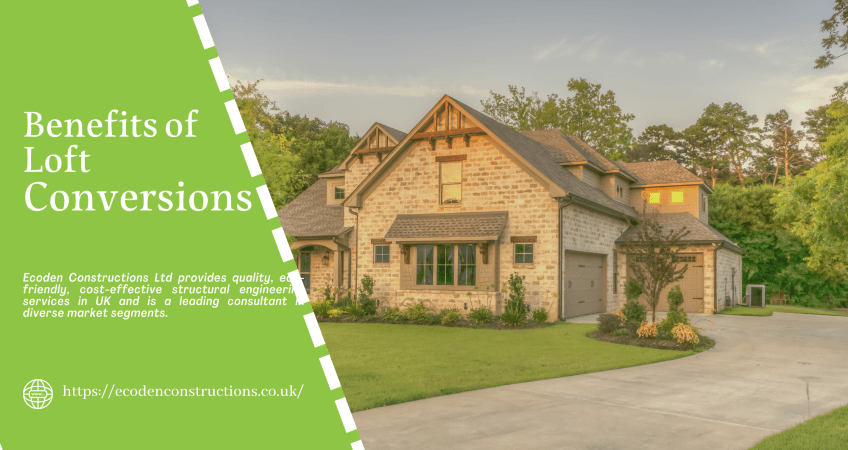Homeowners choose loft conversions because they represent a popular residential renovation strategy to unlock hidden rooms in their houses. The conversion of loft spaces enables homeowners to make efficient use of their house through new rooms while requiring only a fraction of the cost of building an extension. This detailed overview examines both the many advantages of loft conversions and vital planning aspects while explaining how such projects offer remarkable worth for your residential real estate.
What Is a Loft Conversion?
A loft conversion involves transforming the underutilized attic or loft area of your home into a functional living space. This renovation can include adding insulation, flooring, windows, and electrical installations to create a comfortable and usable area.
Popular Types of Loft Conversions
Before diving into the benefits, it’s essential to understand the common types of loft conversions:
- Dormer Loft Conversion:
- Adds a box-shaped extension to the existing roof.
- Provides additional headroom and floor space.
- Ideal for creating spacious rooms with natural light.
- Velux (Roof Light) Loft Conversion:
- Involves installing Velux windows without altering the roof structure.
- Cost-effective and less invasive.
- Suitable for properties with ample loft space and headroom.
- Hip-to-Gable Loft Conversion:
- Extends the sloping side of the roof to create a vertical wall.
- Best suited for detached and semi-detached homes.
- Increases internal space significantly.
- Mansard Loft Conversion:
- Involves extensive roof alterations to create a nearly vertical wall.
- Maximizes loft space and allows for multiple rooms.
- Typically requires planning permission.
Key Benefits of Loft Conversions
1. Increased Living Space
One of the most significant advantages of a loft conversion is the additional living space it provides. Whether you need an extra bedroom for a growing family, a dedicated workspace, or a cozy retreat, converting your loft allows you to make the most of your existing property without sacrificing garden space.
2. Cost-Effective Alternative to Moving
Moving to a larger home can be costly and stressful. A loft conversion provides a budget-friendly solution to gain more space without the hassle of relocating. Compared to home extensions, loft conversions often require less structural work and lower construction costs.
3. Enhanced Property Value
A well-executed loft conversion can increase your home’s market value by up to 20%. Prospective buyers often seek properties with additional living areas, making loft conversions an attractive feature when it comes time to sell.
4. Improved Energy Efficiency
During the loft conversion process, high-quality insulation is typically installed, leading to better energy efficiency. This not only helps maintain a comfortable indoor temperature but also reduces energy bills over time.
5. Versatility and Customization
Loft conversions offer a versatile way to tailor your home to meet your specific needs. Whether you desire a modern design with skylights or a rustic charm with exposed beams, loft spaces can be customized to match your lifestyle and aesthetic preferences.
6. Minimal Disruption to Daily Life
Compared to other home renovation projects, loft conversions typically cause minimal disruption. Most of the work is carried out within the loft area, reducing the impact on your daily routine.
7. Utilizing Unused Space
Many homeowners neglect their lofts, using them only for storage. A loft conversion transforms this neglected space into a functional, valuable area without taking up additional land.
Essential Planning Considerations for Loft Conversions
Planning Permission
In many cases, loft conversions fall under permitted development rights, meaning they don’t require planning permission. However, larger conversions or those altering the external appearance of the property may need approval from local authorities.
2. Building Regulations Compliance
All loft conversions must comply with building regulations to ensure structural integrity, fire safety, insulation, and ventilation requirements are met. Working with an experienced contractor can help navigate these legal requirements.
3. Structural Integrity
Before starting a loft conversion, a structural assessment of the existing roof and floor is essential. Reinforcements may be necessary to support the additional load.
4. Budget Planning
Having a clear budget in place is crucial for a successful loft conversion. Consider factors such as materials, labor costs, permits, and unexpected expenses to avoid overspending.
5. Access and Staircase Design
Proper access to the loft is vital for functionality and safety. Space-saving staircase options, such as spiral or retractable stairs, can help optimize available space.
6. Natural Light and Ventilation
Incorporating roof windows, dormers, or skylights ensures adequate natural light and ventilation, creating a bright and airy space.
7. Choosing the Right Contractor
Selecting a reputable and experienced contractor is key to achieving a high-quality loft conversion. Check reviews, request references, and compare quotes before making a decision.
How Loft Conversions Compare to Home Extensions
| Feature | Loft Conversion | Home Extension |
|---|---|---|
| Cost | Lower | Higher |
| Time to Complete | Shorter (6-12 weeks) | Longer (several months) |
| Planning Permission | Often not required | Typically required |
| Space Utilization | Uses existing structure | Requires additional land |
| Impact on Property | Minimal exterior changes | Major changes to layout |
Creative Loft Conversion Ideas
- Home Office: Create a quiet and productive workspace away from household distractions.
- Guest Bedroom: Provide comfortable accommodations for visiting friends and family.
- Children’s Playroom: Offer a dedicated play area to keep toys and activities organized.
- Entertainment Room: Design a cozy space for watching movies or gaming.
- Personal Gym: Set up a fitness area to stay active without leaving home.
Conclusion
A loft conversion is a smart and practical way to enhance your home’s functionality, value, and aesthetic appeal. Whether you’re looking to accommodate a growing family or simply maximize your living space, a well-planned loft conversion can provide lasting benefits. With careful planning and the right professionals, your loft can be transformed into a stunning and valuable asset for years to come.
If you’re considering a loft conversion, now is the perfect time to explore the possibilities and unlock your home’s true potential!



